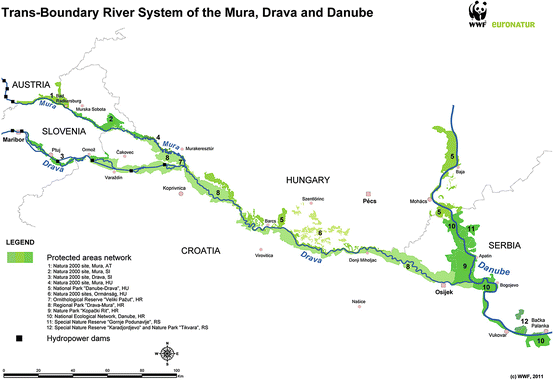- Home
- Prelims
- Mains
- Current Affairs
- Study Materials
- Test Series
Mura-Drava-Danube (MDD) biosphere reserve - world’s first ‘five-country biosphere reserve’.
Recently, the UNESCO designated Mura-Drava-Danube (MDD) as the world’s first ‘five-country biosphere reserve’.


- MDD’s recognition was a mandate to all five countries to jointly advance the protection and revitalisation of the Mura-Drava-Danube area and boost sustainable business practices.
- The reserve is home to floodplain forests, gravel and sand banks, river islands, oxbows and meadows.
- It is home to continental Europe’s highest density of breeding white-tailed eagle, as well as endangered species such as the little tern, black stork, otters, beavers and sturgeons.
- It is also an important annual resting and feeding place for more than 250,000 migratory birds.
- Almost 900,000 people live in the biosphere reserve.
- The reserve represented an important contribution to the European Green Deal and contributes to the implementation of the EU Biodiversity Strategy in the Mura-Drava-Danube region.
- The strategy’s aim is to revitalise 25,000 km of rivers and protect 30 per cent of the European Union’s land area by 2030.
- Additional projects for nature and people are already being implemented in the area.
- These projects put river revitalisation, sustainable business practices enhancing cross-border cooperation into focus.
- Interreg Danube Transnational Programme: funded Amazon of Europe Bike Trail, a long-distance cycling trail following the Mura, Drava and Danube river landscapes for over 1,250 km.
Mura-Drava-Danube (MDD)
- This transboundary biosphere reserve stretches along the Drava, Mura and Danube Rivers, which are separated by flood prevention dykes into an inundation area and a flood-controlled side.
- The biosphere reserve provides an important tool in learning different approaches to floodplain management.
- The biosphere reserve covers 700 kilometres of the Mura, Drava and Danube rivers and stretches across Austria, Slovenia, Croatia, Hungary and Serbia.
- The total area of the reserve in the ‘Amazon of Europe’, makes it the largest riverine protected area on the continent.
- Located in the eastern part of the country, this biosphere reserve includes the largest preserved complex of floodplains in Slovenia, where the interweaving of natural factors and human presence has created an exceptional cultural riverine landscape.
- The area of the biosphere reserve belongs to the Continental Biogeographic Region.
- The core area is a mosaic of well-preserved characteristic habitats of the middle sections of dynamic river floodplains.
- The Drava River is both the fourth largest and fourth longest Danube tributary rising in Italy.
- It drains from the southern side of the Alps to the Danube and the Black Sea.
- The Drava flows through Austria, Slovenia and Croatia. It forms the border between Croatia and Hungary, before heading back into Croatia again to meet the Danube near Osijek, where it is 320 metres wide.
- The Drava River is a typical fluvio-glacial river, which means that its highest flow is in July during the melting of glaciers, while the majority of other rivers are already showing signs of summer drought.
- The longest river in the European Union, the Danube River is the second-longest river in Europe after Russia’s Volga.
- It begins in the Black Forest region of Germany and runs through 10 countries (Germany, Austria, Slovakia, Hungary, Croatia, Serbia, Romania, Bulgaria, Moldova and Ukraine) on its way to the Black Sea.
- 19 countries share the Danube River Basin, which makes it the world’s most international river basin.
- Biosphere reserves are ‘learning places for sustainable development’.
- They are sites for testing interdisciplinary approaches to understanding and managing changes and interactions between social and ecological systems, including conflict prevention and management of biodiversity.
- They are places that provide local solutions to global challenges.
- Biosphere reserves include terrestrial, marine and coastal ecosystems.
- Each site promotes solutions reconciling the conservation of biodiversity with its sustainable use.
- Biosphere reserves are nominated by national governments and remain under the sovereign jurisdiction of the states where they are located.
- Biosphere Reserves are designated under the intergovernmental MAB Programme by the Director-General of UNESCO following the decisions of the MAB International Coordinating Council (MAB ICC).
- Their status is internationally recognized. Member States can submit sites through the designation process.
- UNESCO biosphere reserves are central to education, research and awareness-raising work to foster innovative sustainable development practices and combat the loss of biodiversity.
- The network supports local and indigenous communities and Member States’ understanding, and the protection of the natural environment.









 Latest News
Latest News
 General Studies
General Studies